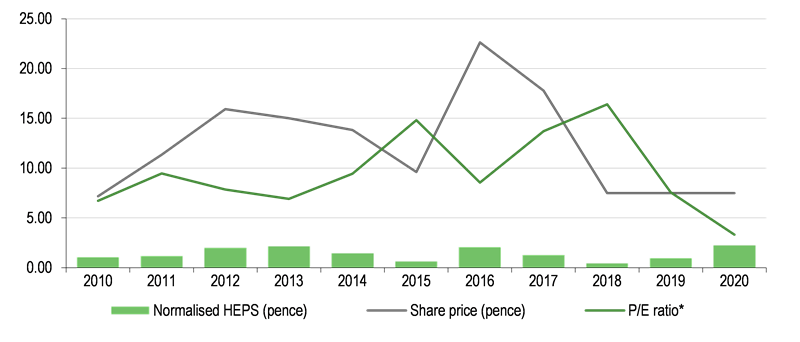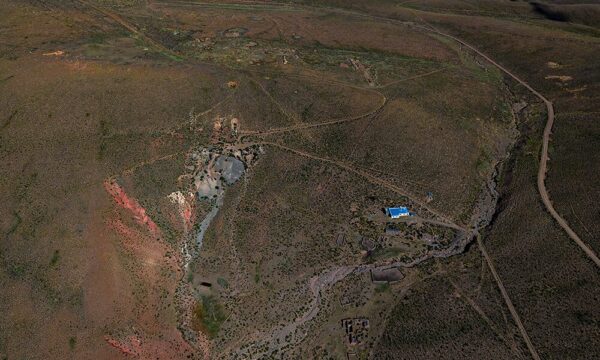In addition to Elikhulu, PAF has three other significant growth projects, namely Egoli (formerly the Evander Mines 7 Shaft No. 3 Decline and 2010 Pay Channel project), the Royal Sheba project and the Barberton Mines Sub-Vertical Shaft project at Fairview.
Egoli (formerly Evander Mines 7 Shaft, No. 3 Decline and 2010 Pay Channel)
The 2010 Pay Channel contains an estimated 2.95Moz of resources (of which 1.03Moz are in the measured and indicated categories) at an average grade of 9.75g/t and is c 4.5km in tramming distance from 7 Shaft, which is used by EGM for hoisting to the Kinross metallurgical plant (cf 8 Shaft, which is c 12km distant). The previous operator, Harmony, had previously developed the 7 Shaft mine working towards the 2010 Pay Channel, but discontinued the initiative in 2009, allowing the controlled flooding of the development ends and 7 Shaft’s No. 3 Decline, from 21 Level to 18 Level. To date, two boreholes have successfully been drilled into the 2010 Pay Channel, intersecting the Kimberley reef at a depth of c 2km. The first yielded a reef intersection with a width of 49cm and a grade of 36.04g/t (a metal content factor of 1,766cm.g/t), while the more recent recorded a width of 6cm and a grade of 36.8g/t (a metal content factor of 221cm.g/t). Additional drilling deflections are being performed to further delineate the orebody.
In the meantime, a feasibility study on the project has been completed with the following major features:
■
Existing available plant and shaft capacity will be used to treat the mined ore.
■
Initial de-watering of the declines is expected to commence during CY18, after which only standard footwall and on-reef development (with associated engineering infrastructure) is required.
■
The mining operation will be planned to ensure that waste and reef are hoisted separately (this is in contrast to the existing operation at Evander, which is a contributory factor to grade dilution).
■
Recoverable gold is estimated to be 13,000oz per year for the first four years of development and c 65,000oz per year for the next 10 years thereafter at an all-in sustaining cost of ZAR275,000/kg, or US$684/oz at a forex rate of ZAR12.50/USD, over the life of the mine.
■
Peak funding is forecast to be ZAR572m (US$48.2m, or £34.7m, at prevailing forex rates), which is equivalent to US$741 per annual oz of production at full capacity.
■
At a gold price of US$1,287/oz, the project has a (real) pre-tax NPV10 of ZAR1.74bn (US$139.4m), an internal rate of return of 46% and a payback period of two years following the initial four-year development period.
We are not privy to the detailed financial model for Egoli. From the information provided, however, it is able to make a preliminary valuation of the project on a post-tax basis of ZAR929.7m at our updated long-term gold price assumptions (see Exhibit 8) and prevailing forex rates, which equates to 53.4% of PAF’s pre-tax NPV10 of ZAR1.74bn, above (among other things, reflecting a relatively high average gross margin of 47.7% for tax purposes), or ZAR0.52 (4.4 US cents, or 3.2p) per share. Note that the figures provided above also imply a unit cash cost of ZAR2,163 per tonne milled, which approximates our targeted costs for EGM’s existing operations on the Kinross Pay-Channel (see Exhibit 2 and pages 4-5).
While the study inevitably conceives of the Egoli project as an integrated constituent of the broader Evander complex, in view of the section 189 process underway there (see page 6), on 28 March PAF announced it will reassess the feasibility study as a standalone project and that this process is expected to be completed by the end of the current financial year.
Barberton Mines Sub-Vertical Shaft Project at Fairview
The Fairview mining operation is restricted by the hoisting capacity of its No. 3 Decline, which is used to access workings below 42 Level and the high grade MRC 11-block orebody. Currently, the decline is used to transport employees and material as well as for rock hoisting and, with no modifications, future mining at depth will be compromised by increased travelling distances, reduced employee face time and a lack of sufficient capacity to ensure both adequate ore replacement and exploration development. With this in mind, PAF has now completed a study with DRA to investigate the feasibility of constructing a raise-bored, sub-vertical shaft from Fairview’s 42 Level to 64 Level and, potentially, in future, to 68 Level (resources extend down at least to 74 Level). The sub-vertical shaft will then be used to transport employees and material to the working areas, while No. 3 Decline will be used exclusively for rock hoisting, thereby significantly increasing overall capacity and production from this high grade mining area as well as improving ore handling efficiencies.
Estimated capex for the project (including contingencies) is ZAR105m (US$8.9m, or £6.4m at prevailing forex rates) and would result in estimated, additional output of 7,000oz gold per year, which “can be optimised further to more than 10,000oz per year.”
Assuming that construction takes place in CY18 and CY19 and that production begins in CY20 with cash costs of c US$800/oz over 15 years at the gold prices indicated in Exhibit 8 and prevailing forex rates, we estimate that this project could be worth in the order of US$10.5m (0.58c, or 0.42p, per share) to PAF, rising to US$16.4m (0.91c/share) in the event of optimisation (at our standard 10% discount rate).
The Royal Sheba orebody forms part of the Barberton mine and, before 1996, was mined on a small scale to a depth of 340m below surface. In FY10, a concept study was completed with the aim of re-opening the mine as a larger, standalone operation. The study concluded that the project was viable, but required significant capex in the form of a new shaft system from surface and the construction of a new gold plant. Since then, however, three significant synergies have been identified that suggest that capex can be materially reduced. These include:
■
The orebody is conducive to sub-level open stoping. Importantly, this is a massive, mechanised, high volume (eg 30-40kt per month) and relatively low-cost mining method.
■
A development drive from the Sheba mine on the 23 Level (c 600m underground) is being advanced towards the Royal Sheba orebody. A further 800m of development is required and multi-blasting is being investigated to halve the development time from 36 months to c 18 months to access Royal Sheba. Importantly, however, this infrastructure will obviate the need for the new shaft system envisaged in the 2010 study.
■
The Royal Sheba ore is free-milling and non-refractory. Therefore, the BTRP plant can be expanded at a minimal capital cost to treat Royal Sheba ore.
Management believes that Royal Sheba has the potential to produce c 30,000oz of gold per annum, to which end it has commenced a drilling programme of 14 holes from surface, totalling 12,000m (an average of 857m/hole), to increase geological confidence in the orebody and to contribute towards a feasibility study, which is expected to be completed in CY18. In the meantime, management has developed a full three-dimensional model of the Royal Sheba ore body, incorporating the structural, lithological and mineralisation components of the deposit, which has resulted in an increase in resources both adjacent to and below the current mine infrastructure and a formal upgrade in its mineral resource estimate, as follows:
Exhibit 7: Royal Sheba March 2018 mineral resource estimate vs previous
|
March 2018 |
|
Change vs previous (units) |
|
Change vs previous (percent) |
Category |
Tonnes (kt) |
Grade (g/t) |
Contained gold (Moz) |
|
Tonnes (kt) |
Grade (g/t) |
Contained gold (Moz) |
|
Tonnes (%) |
Grade (%) |
Contained gold (%) |
Measured |
2,720 |
3.91 |
341,932 |
|
2,335 |
(0.24) |
290,511 |
|
605.7 |
(5.8) |
565.0 |
Indicated |
1,340 |
3.22 |
138,725 |
|
(14) |
(1.13) |
(50,673) |
|
(1.1) |
(26.0) |
(26.8) |
Inferred |
1,830 |
4.05 |
238,287 |
|
974 |
(0.3)5 |
118,505 |
|
113.7 |
(8.0) |
98.9 |
Total |
5,890 |
3.80 |
718,945 |
|
3,294 |
(0.52) |
358,765 |
|
126.9 |
(12.0) |
99.6 |
Source: Pan African Resources, Edison Investment Research. Note: Reported in accordance with the South African Code for the Reporting of Exploration Results at a cut-off grade of 2.5g/t, derived by applying a gold price of ZAR600,000/kg (equivalent to US$1,435/oz at ZAR13.00/US$).
The updated mineral resource estimate considers 10 domains within the deposit and is staged over a larger down-dip extent than previously, owing to the variogram model parameters applied. Relative to PAF’s prevailing resource multiple of US$7.14/oz, a 358.8koz resource increase has a pro-rata value of US$2.6m.


























